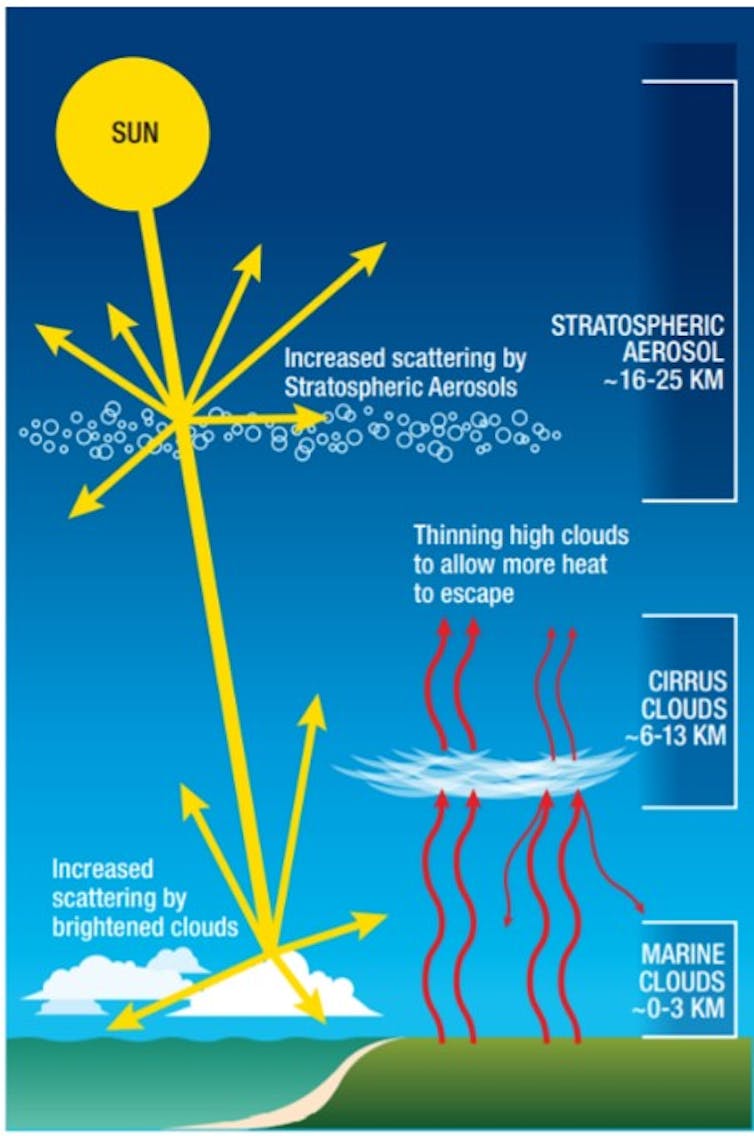#What’s solar geoengineering… and why is it controversial?

Table of Contents
“#What’s solar geoengineering… and why is it controversial?”
The report, produced by a committee of 16 experts from diverse fields, does not take a position but concludes that the concept should be studied. It calls for creating a multidisciplinary research program, in coordination with other countries and managed by the U.S. Global Change Research Program, that seeks to fill in the many knowledge gaps on this issue.
The study emphasizes that such research is not a substitute for cutting greenhouse gas emissions and should be a minor part of the U.S. response to climate change. It notes that “engineering the climate” would not address the root cause of climate change – greenhouse gas emissions from human activities. And it calls for a research program that draws on physical science, social science and ethics and includes public input.
These perspectives from three members of the study committee underline the complexity of this issue.
Three options, many questions
James W. Hurrell, Professor and Scott Presidential Chair of Environmental Science and Engineering, Colorado State University
Solar geoengineering strategies are very controversial within and beyond the climate science community. It is a major step forward to have 16 experts from different disciplines agree that now is the time to establish a research program on this topic. Our committee traveled a long road to reach this recommendation, working through many complex and contentious issues to reach consensus, but we did it collegially and productively. Each of us learned a great deal.
The three options we considered raise many questions:
– Stratospheric aerosol injection would increase the number of small reflective particles (aerosols) in the upper atmosphere to increase reflection of sunlight back into space. While strong evidence exists that this approach can induce cooling at a global scale, there is limited understanding of how cooling potential relates to the amounts of injected aerosols, their location and type, and the ensuing regional climate responses and impacts.
– Marine cloud brightening would add materials to low clouds over the ocean to make them more reflective. Water vapor in clouds condenses into droplets when it comes into contact with particles, such as salt; adding particles produces more droplets, making the clouds more reflective.
Where and by how much the brightness of clouds can be modified, and whether feedback processes will mask or amplify some of the effects, are important research questions. Key processes occur at scales too small to include directly into the current generation of global climate models, and these process uncertainties will need to be reduced in order to develop reliable projections of climate impacts.
– Cirrus cloud thinning would seek to reduce the formation of wispy, thin clouds that retain heat radiating upward from Earth’s surface. The efficacy of this approach is unknown because of very limited understanding of cirrus cloud properties and the microphysical processes determining how cirrus clouds may be altered. Existing climate model simulations have yielded contradictory results.
Given the risks of rapid warming and its impacts, it is important to consider a portfolio of response options, and to understand as quickly and efficiently as possible whether solar geoengineering could be a reasonably safe and effective option. A transdisciplinary, coordinated and well-governed research program might prove that more investment is warranted. Or it could indicate that solar geoengineering should not be considered further. The key point is that either outcome will be guided by sound science.

A thoughtful and inclusive process
Ambuj D. Sagar, Founding Head, School of Public Policy, and Professor of Policy Studies, The Indian Institute of Technology Delhi
Few climate issues are as polarizing as solar geoengineering, and for good reason. To many, even considering it could dilute efforts to cut emissions. It also reinforces the notion that as a society we are willing to place our faith in technology to solve our self-inflicted problems.
But refusing to engage with solar geoengineering also raises questions. Can we be sure that we won’t need it in the future? What if greenhouse warming generates horrendous climate impacts? And if it turns out that solar geoengineering is not technically feasible or socially acceptable, should we not learn that now?
This report recognizes that there is value in understanding more about the feasibility, acceptance, risks, ethics and governance of solar geoengineering to inform decision-making. But it also calls for a measured, nuanced and integrative approach. And it makes the point that exploring solar geoengineering should not compromise research or action on climate mitigation and adaptation.
Public engagement and participation, and insights from various disciplines, are key to carrying out effective research on solar geoengineering. At the same time, suitable expertise and institutional arrangements are needed to engage better with this complex topic. We need to understand how to effectively enhance such participation and strengthen such capacity.
Paying attention to these issues will open the door to including perspectives and researchers from the global south and other communities that often are marginalized. It also will help make the research agenda more robust and help people better understand potential risks around the world from solar geoengineering. A strong and inclusive research program should also fully involve developing countries and other relevant communities in exploring governance models for solar geoengineering.
Our panel recommended that the proposed U.S. research program be carried out in coordination with other countries. We hope this approach will spur deeper engagement worldwide, especially by developing countries that need to be part of global conversations and decisions on this issue.
Overall, I hope that the perspectives and approaches presented in this report will catalyze a thoughtful and socially robust research program and equally thoughtful deliberations by scholars, policymakers, and citizens on this thorny topic.

Broadening the discussion
Marion Hourdequin, Professor of Philosophy, Colorado College
Geoengineering evolved from a fringe concept to a serious research topic less than 20 years ago, and today solar geoengineering technologies are largely in the idea stage. Computer modeling simulations and natural analogs such as volcanoes indicate that adding reflective aerosols to the stratosphere or increasing the “brightness” of marine clouds could have cooling effects. However, there are risks and uncertainties associated with these approaches, and the potential benefits – which may not be evenly distributed around the globe – are not well understood.
For example, scientists know very little about the regional effects of different solar geoengineering strategies. And researchers are just starting to explore the ecological, social, political, economic, and ethical dimensions of these approaches.
What’s more, many people in the U.S. and the world are unaware that research is moving forward and outdoor experiments have been proposed. So far, discussions about solar geoengineering have been concentrated among a relatively small group of researchers, primarily from North America and Europe.
But like climate change itself, solar geoengineering would affect everyone. The technologies that our committee considered would have global and multigenerational effects. With this in mind, now is the time for broader and more inclusive conversations about how solar geoengineering should be studied and governed – and whether or not it should be seriously considered. These conversations need to include climate-vulnerable communities, Indigenous peoples and nations of the global south.
Our committee’s report calls for a program that weaves together multidisciplinary research, public and stakeholder engagement, and thoughtful limits and guidelines for research. This program should facilitate cooperation and capacity building, support a more demographically and geographically diverse research community, enable equitable participation and prioritize strategies that build trust, transparency, and legitimacy.
Geoengineering raises big technical, social and ethical questions that should be informed by research but can’t be adequately answered by a small set of experts. And regardless of what we learn through geoengineering research, one thing is clear: Reducing emissions, decarbonizing economies and supporting adaptation to current and future climate impacts need to take center stage.![]()
This article, by James W. Hurrell, Professor and Scott Presidential Chair in Environmental Science and Engineering, Colorado State University; Ambuj D Sagar, Founding Head, School of Public Policy, and Vipula and Mahesh Chaturevdi Professor of Policy Studies, The Indian Institute of Technology Delhi, and Marion Hourdequin, and Professor of Philosophy, Colorado College is republished from The Conversation under a Creative Commons license. Read the original article.
If you liked the article, do not forget to share it with your friends. Follow us on Google News too, click on the star and choose us from your favorites.
For forums sites go to Forum.BuradaBiliyorum.Com
If you want to read more like this article, you can visit our Technology category.